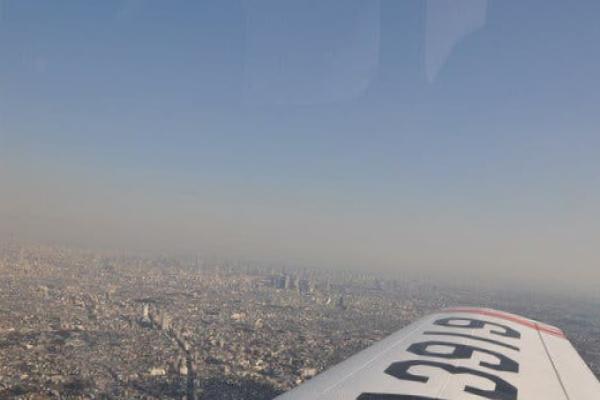Science
These germs found at high altitudes could potentially aid in the global spread of disease
10,000 Feet Up, Scientists Found Hundreds of Airborne Germs. In 10 flights over Japan, researchers found a host of bacteria and fungi.
Updated 2024-Oct-04 22:34

The wing of an airplane with bold lettering on it over a cityscape.
He and his colleagues are currently utilizing new technologies to study samples from Japan and have discovered more organisms like viruses.
Despite potentially finding more pathogens in the winds it is still uncertain if these germs can effectively transmit diseases between locations.
Pathogens traveling at 10 000 feet above ground are much less common than those that accumulate when sick individuals breathe out in buildings with poor ventilation.
Schmale mentioned that occasionally only one pathogen is needed to cause infection. These environmental areas have not been explored and require further examination.
Some are part of communities that are recognized to reside within our bodies. Some members of the human microbiome are peaceful but others can lead to harmful infections according to Dr.
Rodó suggested that the extensive farming of crops and livestock in northwestern China could make it a significant origin of pathogens.
Big plumes of dust can be generated by erosion. Microbes from the soil fertilizer or sewage may have the potential to induce diseases.
The sky may not seem like a promising place to find life. But in the 1920s scientists flew planes across the United States and caught floating spores.
A century later the living atmosphere remains a fairly mysterious place. On Monday researchers reported that on flights over Japan at altitudes as high as 10 000 feet they had caught hundreds of different types of bacteria and fungi.
The team estimated that the microbes had flown over 1 200 miles when they were captured. Most intriguing of all some of the species might be able to cause diseases in people.
A third of the bacteria and slightly more of the fungi can be considered potential human pathogens said Xavier Rodó a computational ecologist at the Barcelona Institute for Global Health who led the work.
Dr. Rodó cautioned that the new study offered no direct evidence however that high altitude microbes could cause human outbreaks when they fell to the ground.
But he argued that it offered hints that winds helped spread diseases. This is something that deserves attention he said.
The idea for the flights originated from Dr. Rodó’s research into a mysterious condition known as Kawasaki disease which causes fevers rashes and sometimes deadly heart attacks.
Researchers have long debated whether the disease is caused by a pathogen a faulty immune system or a combination of the two.
Cases of Kawasaki disease come in surges. Dr. Rodó and his colleagues found that surges in Japan often occurred when winds blew in from northeast China.
And when those same winds reached California cases rose there as well. We didn’t expect winds to be really playing a role but it came out in a way that was really striking for me Dr.
Rodó said. The region of China where the winds came from has many massive farms and livestock operations along with open pit mines.
The research suggested that something was traveling in the winds something possibly alive. So I thought let’s go and chase whatever is there Dr.
Rodó said. His team flew a Cessna airplane into air masses that blew from China over the Sea of Japan.
The plane rose above the turbulent lower atmosphere reaching the free troposphere a layer where air masses can quickly move long distances.
An inlet opened on the side of the plane allowing air to flow into a tube that led to a filter where airborne particles were trapped.
David Schmale an aerobiologist at Virginia Tech expressed astonishment at the human pathogens they found in the study.
He proposed the idea that they could be innocent family members of harmful bacteria. He suggested that the most effective method to determine their actual essence would be to introduce the virus into either human cells or animals in a laboratory setting.
Rodó mentioned that he and his peers were getting ready to conduct tests where air samples would be exposed to human lung cells.
Rodó the recent study does not provide a resolution to the enigma of Kawasaki disease. There is a possibility that multiple pathogens could potentially cause the disease as well as a possibility that children are at risk only if they breathe in pollution brought by the same winds.
We are still unaware of what is yet to come.
